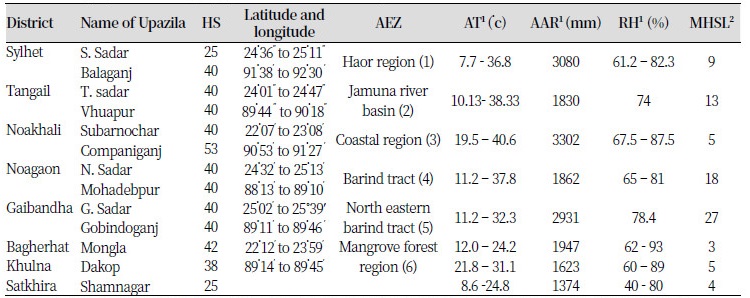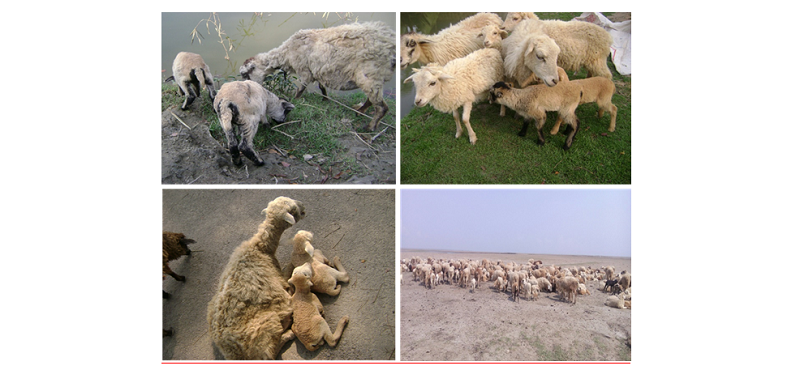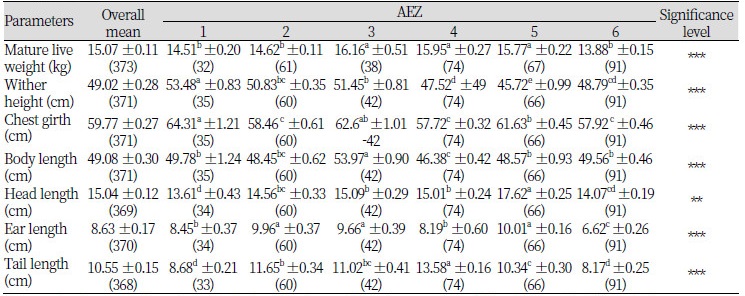Introduction
Livestock is an integrated component of agro-based farming in Bangladesh that contributes 2.5 percent of the national GDP in the FY 2016-17 (BER, 2017). About 15.4 percent of the total protein consumed comes from livestock products, which increased by 4.3 percent during the period between 1990 and 2008 (FAO, 2010). Importantly, about 50 percent of the total population in Bangladesh receive indirect benefits from livestock for their livelihoods (DLS, 2016). Sheep stand third in number among the ruminant species in Bangladesh and are used primarily for meat production. The size of sheep population in the country is estimated to be 3.22 million (BER, 2016). Most of them are non-descript indigenous type with few crossbreds and have relatively better resistant to parasitic diseases (Bhuiyan, 2006). Indigenous sheep of Bangladesh are sparsely distributed throughout country with a relatively higher concentration in several agro-ecological zones; coastal regions, barind tracts, north-eastern wetlands, sundarban-delta regions and Jamuna river basin areas (Pervage et al., 2009). Sheep are well adapted to hot and humid agro-climatic conditions, capable of lambing twice a year each with multiple births (Hassan and Talukder, 2011). They are efficient users of low quality roughages and also can utilize efficiently stubbles of cultivated crops, tree toppings, farm waste, small vegetation in harvested fields or fallow lands, roads and canal side grasses, and even graze on aquatic weeds and grass in knee-deep water which makes them suitable for swampy habitat as well as in coastal regions (Banerjee et al., 2010).
Apart from the non-descript indigenous, a well-recognized sheep breed ‘Garole’ is prevalent in and around the districts adjoining the Sunderban delta region of Bangladesh and in the state of West Bengal (Singh and Bohra 1996; Sharma et al., 1999; Sahana et al., 2001). Garole is considered as a reservoir of the Booroola gene (FecB gene) which is responsible for the high prolificacy in sheep (Ghalsasi and Nimbkar, 1993). The prolificacy attributes were introduced into Australian Merino in early 20th century to improve the number of births and developed CSIRO Booroola Merino (Piper and Bindon, 1996). The importance of Garole sheep is well recognized by the rural villagers of south-western part of Bangladesh for their sustenance in coastal regions. In fact, indigenous sheep are less cared animals in Bangladesh and have been reared under traditional husbandry practices by rural people. This valuable germplasm is still being neglected and very little attention has been paid until to date for their improvement. Indigenous non-descript sheep of Bangladesh is a valuable genetic resource, especially in their contribution to the overall genetic diversity and their stable production under rural condition even with changing climate. Quite recently, community managed sheep breeding program has been implemented by government institutes (Department of Livestock services, DLS and Bangladesh Livestock Research Institute, BLRI) for their genetic improvements in some sheep potentials areas of Bangladesh (Bhuiyan et al., 2017). As initial step of the said breeding program, information was collected to know the prevailing sheep production systems and their genetic potentials. Thus, this study was conducted to investigate on morphology, morphometric characteristics, productive and reproductive potential of indigenous sheep of Bangladesh.
Materials and Methods
Investigations were carried out in six different geographic locations of Bangladesh namely Haor region-1, Jamuna river basin-2, Coastal rgion-3, Barind tract-4, Northeastern barind tract-5 and Mangrove forest region-6, which included thirteen upazilas from eight districts. Details on geographic locations (latitudes and longitudes), including respective upazilas and distracts are presented in Table 1. These six regions were selected due to have better concentration of indigenous sheep as well as to have representation of total geographic scenarios of the country. A semi structured questionnaire was prepared for this purpose. Data were collected from the farmers’ flock either in consultation with farm owners, visual estimation and on-spot recording. Data were recorded on three to four unrelated individuals from each flock on traits related to morphometry and growth production and reproduction. The morphometric characteristics of both sexes were measured using the weighing balance and measuring tape from adult animals only, with age varied between 1.5 to 3 years. The studied traits were body length (BL), chest girth (CG), wither height (WH), head length (HL), ear length (EL), tail length(TL), scrotal length (SL) and scrotal circumference (SC). The following productive and reproductive traits were included such as lamb birth weight (BWT), weaning weight (WWT), six months weight (SMWT), mature live weight (MLWT), age at first lambing (AFL), lambing interval (LI), postpartum heat period (PPHP), liter size (LS), service per conception (S/C) and age at culling (AC). The age of the animals was recorded based on dentition pattern as well as farmer’s information. In addition, reproductive parameters were determined mostly on the basis of farmers recalled and on spot observation of the animals.
Statistical analysis
The collected data were checked, compiled and screened for outlier observation those didn’t within the range of Mean ±3SD. Then screened data were processed for statistical analysis using SAS (version 9.3.1). The mean±SE has been calculated for morphometric, productive and reproductive performance of rams and ewes in relation to location and management. In case of significant independent variable, the differences among the treatment means were examined by using Duncan Multiple Range Test (DMRT) using the same software. The data on studied traits were analyzed using the following statistical model
Yijk = µ + Li + Sj + Mk + eijk
Where, Yijk is the observed value of a trait, µ is the population mean, Li is the effect of location (i = 1 to 6), Sj is the effect of sex (j= 1 and 2, male = 1, 2 = female), Mk is the effect of management (k = 1 and 2; 1 = semi-intensive and 2 = intensive) and eijk = random error associated with Yijk observation with mean zero and common variance (σ2).
Results and discussion
Coat colors
The coat color distribution observed in indigenous sheep of Bangladesh in six different locations are shown in Figure 1 and 2. Of different coat colors, cream or whitish color was observed most frequent in each location that ranging from 34% to 89% of the total population with mean of 62%. The highest proportion of dark brown coat color (47%) was observed in Sylhet district (Haor region) and lesser extent in other geographic regions ranging between (0 to 16%). However, mixed coat colors are the highest (56%) in Mangrove forest region followed by cream or white. These results are in consonance with the findings of Tsunoda et al. (1984), Rahman (1988), Pervage et al. (2009), and Hassan and Talukder (2011) for indigenous sheep of Bangladesh. Pervage et al. (2009) reported that coat colors of sheep of coastal region were mostly white or light to deep brown but sheep of Jamuna region and Barind tract were either whitish, brown, blackish-red and black or white mixed. The difference in coat color distribution between current and previous studies might be due to sampling locations, sample size and unplanned mating in the studied population.
Morphometric features
The morphometric features of indigenous rams and ewes are shown in Table 2 and 3, respectively. The average mature live weights (MLW) of rams and ewes were 17.90 ±0.23 and 15.07±0.11 kg, respectively and differed significantly (P<0.001) among the considered locations for both sexes. The lowest MLW was observed in the sheep population of mangrove forest area known as Garole which is familiar for smaller body size with higher prolificacy in Bangladesh. This result is agreed with the previous findings of Hasanath (1980), Pervage et al. (2009) in indigenous sheep of Bangladesh as well as Banerjee (2015) in the Bengal sheep of West Bengal in India. The WH ranged from 50.92±1.19 to 66.12±0.98 cm with mean of 58.47 cm in rams and were 45.72±0.99 to 53.48±0.83 cm with an average of 49.02±0.28 cm in ewes. The WH had significant differences across the locations. This finding is supported by the previous results of Pervage et al. (2009) and Hassan and Talukder (2011). They reported that the WH of native sheep of Bangladesh ranged between 60 to 70 cm.
The lowest chest girth (CG) was observed in the sheep of Mangrove forest region while the highest value was found in coastal areas sheep. There was significant variation among the considered locations in both sexes for this trait. However, the lowest CG of rams was found in the barind sheep population among the considered locations. Pervage et al. (2009) found the CG in BLRI, Jamuna, Barind and Coastal sheep to be 67.73, 58.57, 60.20 and 67.50 cm respectively and are within the range of the present study. The body lengths (BL) of rams were observed as 48.41, 48.70, 50.57, 53.66, 62.32 and 65.78 cm in locations 5, 4, 6, 2, 3 and 1, respectively and the values were 46.38, 48.45, 48.57, 49.56, 49.78 and 53.97 cm in ewes for the locations 4, 2, 5, 6,1 and 3. Hassan and Talukder (2011) found the BL in Jamuna river basin, Barind and Coastal regions sheep 41.5, 43.4 and 45.9 cm, respectively. The head length (HL) had significant variation in both male and female population in the studied locations. The mean HL were 16.15±0.24 and 15.04±0.12 cm in rams and ewes whereas the highest value (19.04±0.72 cm) possessed by the rams of north eastern barind tract. The ear lengths (ER) of indigenous sheep varied significantly among the six studied populations both in male and female which ranged from 6.46±0.72 to 13.62±0.49 cm with a mean 11.23±0.32 cm. The highest ear length was observed in Coastal sheep and was lowest in mangrove forest areas; where has prevailing of Garole sheep those bear vestigial ears. Similar observations were reported by Bose et al. (1999), Banerjee and Banerjee (2000), and Banerjee (2003) in Garole sheep of West Bengal in India. Small or rudimentary ear is the characteristics feature of Garole sheep and our results are in consistent with the previous findings. Present result is also agreed with the findings of Tsunoda et al. (1988) and Pervage et al. (2009). The indigenous sheep of Bangladesh is short and thin tailed type, having tail length of 8.17±0.25 to 13.58±0.16 cm with mean 10.55±0.15 cm and 8.50±0.23 to 14.03±0.48 cm with mean 10.83±0.23 cm for both in ewes and rams. Location had insignificant effects on tail length for both sexes. The result of tail length is in close agreement with Hassan and Talukdar (2011) for indigenous sheep of Bangladesh and with Banerjee (2003) for Garole sheep of West Bengal in India. Scrotal length (SL) and scrotal circumference (SC) have significant effect in volume of semen production. The SL mean was found 10.23±0.20 cm having highest (13.67±0.40 cm) value in the rams of north eastern barind tract and that of lowest (7.52±0.29 cm) was in hoar area rams. Present finding are in accordance with Hassan and Talukder (2011) in native sheep of Bangladesh who reported the testis length to be 10.7, 11.0 and 10.7 cm in Jamuna river basin, Barind and Coastal region respectively.
Productive and reproductive performance of indigenous sheep
Results on productive and reproductive performances of indigenous sheep of Bangladesh are presented in Table 4. All considered productive and reproductive traits were found significant (P<0.001) across locations except the trait S/C. The mean BWT, WWT and SMWT of coastal sheep were 1.16±0.01, 6.63±0.22 and 10.37±0.26 kg respectively and that of were 0.75±0.01, 4.19±0.09 and 7.22±0.13 kg respectively in Haor area sheep. The highest BWT, WWT and SMWT were found in coastal sheep population while the lowest values were observed in the sheep of haor areas. This result is in accordance with the findings of Amin and Husain (2003) and Pervage et al. (2009) who reported birth weight of native sheep were 1.38 and 1.2 kg respectively. Pervage et al. (2009) reported that the weaning weight of BLRI, Jamuna, Barind and Coastal areas sheep were 6.74, 5.74, 5.70 and 5.89 kg respectively, which is closely associated with the present findings. The Mean age at first lambing (AFL) was found 12.81± 0.06 months which ranging between 12.05±0.06 and 13.56 ±0.13 months among the sheep populations. Moreover, the lowest AFL (12.05±0.06 months) was found in Barind sheep. The present findings on AFL across the populations are in agreement with the results of Hassan and Talukder (2011) who reported the average age at first lambing ranged between 389.9±43.0 and 439.5±58.3 days. In contrast, Pervage et al. (2009) and Banerjee (2015) reported higher values than that of present results in Indigenous sheep. This difference might be associated with nutritional status, sampling location, sample size and other management factors. Sarder et al. (2015) reported that age at first lambing were 371±9.0 days in sheep of Barind tract region that also are close to our findings. The trait litter size (LS) was higher in mangrove forest area having the value of 2.36±0.05 and was lower (1.42±0.05) in sheep of Coastal area in Noakhali district. Result of LS in this study is consistent with Sarder et al. (2015), Hassan and Talukder (2011). They reported that LS of indigenous sheep of Bangladesh varied between 1.6±0.2 to 1.90±0.44. In contrast, Pervage et al. (2009) found relatively lower LS compared to our findings. The highest lambing interval (LI) was observed in location 5 (196.45 days) and the lowest (159.56 days) was observed in the sheep of coastal areas. This result is similar with findings of Pervage et al. (2009), Hassan and Talukder (2011). Pervage et al. (2009) who reported that LI of sheep of BLRI, Jamuna, Barind and Coastal region to be 192.17±4.36, 221.13±4.97, 228.57±5.34 and 214.32±4.63 days respectively. The S/C of the present study was 1.19±0.04 and is lower than that of Sultana et al. (2011) but similar with Khan (1989). Furthermore, S/C showed nonsignificant (P>0.05) difference among the sheep populations of studied locations. The highest age at culling (AC) was found (5.21±0.32 years) in the sheep reared in north eastern barind tract while the lowest AC was observed in the sheep of haor region (2.81±0.08 years). The trait AC differed significantly (P˂ 0.01) over the considered locations. Our study depicted that the culling decision made by farm owners varied greatly from location to location.
Conclusion
The present study indicates that indigenous sheep of Bangladesh have notable differences in terms of morphology, production and reproduction capabilities among the geographic locations. The sheep of mangrove region had better prolificacy. However, better growth rate was found in coastal sheep having mostly single birth. In conclusion, this study provided some basic information and important insights on potentialities of Indigenous sheep genetic resources of Bangladesh that could be utilized in planning future national sheep conservation and breeding scheme.








